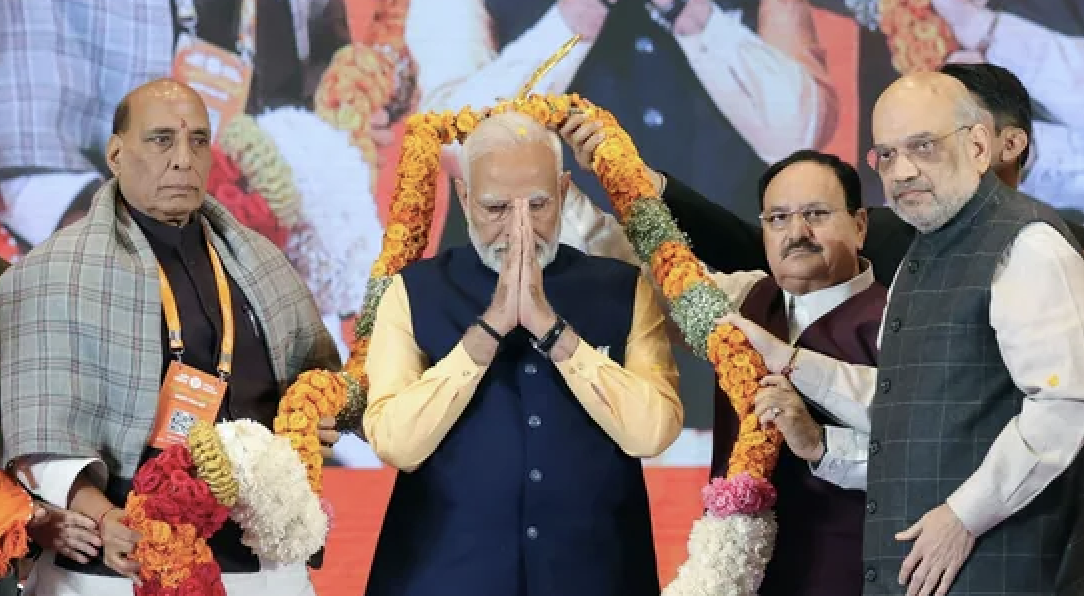The Lok Sabha Election Timeline: Spanning Seven Phases, Voting Scheduled from April 19 to June 1, with Vote Counting Set for June 4.
The Election Commission unveiled the schedule for the seven-phased Lok Sabha elections, marking the beginning of an intense electoral season. Spanning from April 19 to June 1, this monumental democratic process will see the participation of nearly 97 crore voters across 10.5 lakh polling stations. Initially termed the ‘great electoral experiment’ in 1951-52, it remains a pivotal moment in India’s democratic history.
Prime Minister Narendra Modi, alongside Amit Shah, architects of the Bharatiya Janata Party’s triumphs in 2014 and 2019, seeks a third consecutive term in office, a feat achieved previously only by Pandit Jawaharlal Nehru.
Addressing a rally in Madhya Pradesh’s Jhabua last month, the Prime Minister remarked, ‘When the opposition said ’24 mein 400 paar’, I envisioned not just the NDA but the BJP alone crossing 370 seats.’
The BJP faces off against the ‘INDIA’ alliance, a coalition of opposition parties led by the Congress and regional entities. Despite disparities in seat allocations among alliance members, the anti-BJP front endeavors to present a united stance.
Uttar Pradesh
Uttar Pradesh, often cited as the gateway to Delhi, boasts the distinction of being India’s most populous state and has contributed nine prime ministers to the nation, including the current Prime Minister, Modi, who represents Varanasi in the Lok Sabha.
With 80 parliamentary seats, UP holds paramount importance for the BJP’s aspiration to surpass its impressive 2019 Lok Sabha tally of 303 seats. The party remains optimistic that the inauguration of the Ram Mandir in Ayodhya, coupled with the popularity of PM Modi and Chief Minister Yogi Adityanath, will translate into electoral gains exceeding those of both 2014 and 2019.
Facing a significant challenge from the Samajwadi Party, the BJP’s primary rival, the electoral landscape in UP is intensely competitive. In the 2019 polls, the SP, led by Akhilesh Yadav, secured 5 seats, while its coalition partner, the Bahujan Samaj Party, led by Mayawati, won 10 seats.
The Congress, once a dominant force in the state’s political milieu, finds itself battling for relevance. Its electoral performance in UP has dwindled, with just two seats secured in 2014 and one in 2019.
UP will participate in all seven phases of the upcoming Lok Sabha elections.
Southern States
The BJP, often characterized as primarily a party of the northern regions by its critics, has expanded its influence in southern states in recent times. Notably, in Karnataka, the BJP secured 25 out of 28 seats in the 2019 elections. Nonetheless, the Congress aims to leverage its victory in the 2023 assembly polls for success in the Lok Sabha this time around.
In Andhra Pradesh, the BJP has formed alliances with Chandrababu Naidu’s Telugu Desam Party and Pawan Kalyan’s Jana Sena to contest against Jagan Mohan Reddy’s YSRCP.
Telangana, the newly formed state, saw a Congress triumph last December, ending the decade-long rule of K Chandrasekhar Rao’s BRS. The Congress eyes a repeat performance in 2023.
In Tamil Nadu, the DMK and Congress, part of the INDIA alliance, aspire for a strong showing against the AIADMK. Meanwhile, the BJP seeks to increase its presence, capitalizing on controversies such as Udhayanidhi Stalin’s remarks against ‘Sanatan Dharma’.
In Kerala, governed by the CPM, the BJP has nominated Union Minister Rajeev Chandrasekhar to contest against three-time Congress MP Shashi Tharoor in Thiruvananthapuram.

